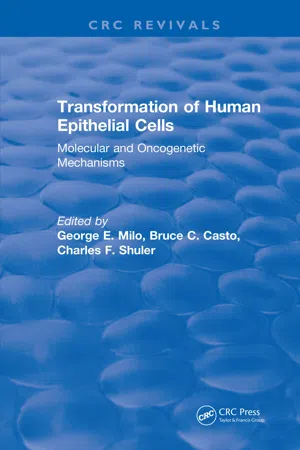
Transformation of Human Epithelial Cells (1992)
Molecular and Oncogenetic Mechanisms
- 326 pages
- English
- ePUB (mobile friendly)
- Available on iOS & Android
Transformation of Human Epithelial Cells (1992)
Molecular and Oncogenetic Mechanisms
About This Book
This book offers a conceptual explanation of the interrelationships that exist between the stages in the progression of initiated epithelial cells in culture compared with the diverse tissue of organs and the progression of tumors from different organ sites. The fate of the modification of adducts is discussed at the molecular level. The role that modifications in hot spots in oncogenes and supressor genes play at the molecular level and how these molecular modifications can lead to an explanation of molecular control in the formation of tumor phenotypes is also examined. Researchers in cell biology and toxicology, applied pharmacology, carcinogenesis, teratogenesis, mutagenesis, and molecular toxicology will find the book useful, interesting reading.
Frequently asked questions
Information
Chapter 1
In Vitro CELLULAR AGING AND IMMORTALIZATION
TABLE OF CONTENTS
I. Introduction
II. In Vitro Cellular Aging is Dominant in Somatic Cell Hybrids
A. Limited In Vitro Life-Span of Normal Cells
B. Hybrids Between Normal and Immortal Cells
C. Fusion of Immortal Cells with Other Immortal Cell Lines
Table of contents
- Cover Page
- Title Page
- Copyright
- Preface
- The Editors
- Contributors
- Table Of Contents
- Chapter 1 In Vitro Cellular Aging and Immortalization
- Chapter 2 Detection of Growth Factor Effects and Expression in Normal and Neoplastic Human Bronchial Epithelial Cells
- Chapter 3 Human Cell Metabolism and DNA Adduction of Polycyclic Aromatic Hydrocarbons
- Chapter 4 Human Esophageal Epithelial Cells: Immortalization and In Vitro Transformation
- Chapter 5 Transformation of Human Endometrial Stromal Cells In Vitro
- Chapter 6 Factors Influencing Growth and Differentiation of Normal and Transformed Human Mammary Epithelial Cells in Culture
- Chapter 7 Transformation of Colon Epithelial Cells
- Chapter 8 Multistep Carcinogenesis and Human Epithelial Cells
- Chapter 9 Morphologic and Molecular Characterizations of Plastic Tumor Cell Phenotypes
- Chapter 10 Oncogene and Tumor Suppressor Gene Involvement in Human Lung Carcinogenesis
- Chapter 11 Events of Tumor Progression Associated with Carcinogen Treatment of Epithelial and Fibroblast Compared with Mutagenic Events
- Chapter 12 Progression From Pigment Cell Patterns to Melanomas in Platyfish-Swordtail Hybrids — Multiple Genetic Changes and a Theme for Tumorigenesis
- Index